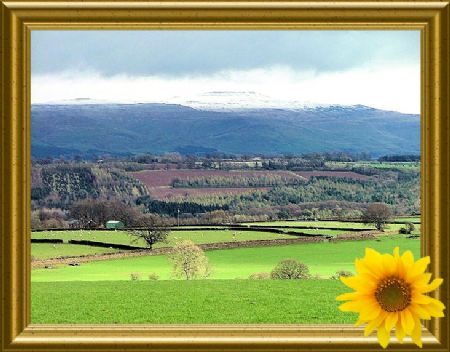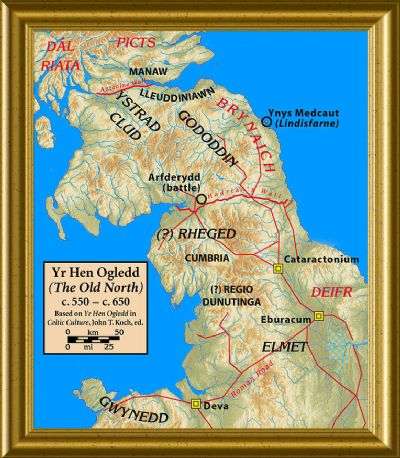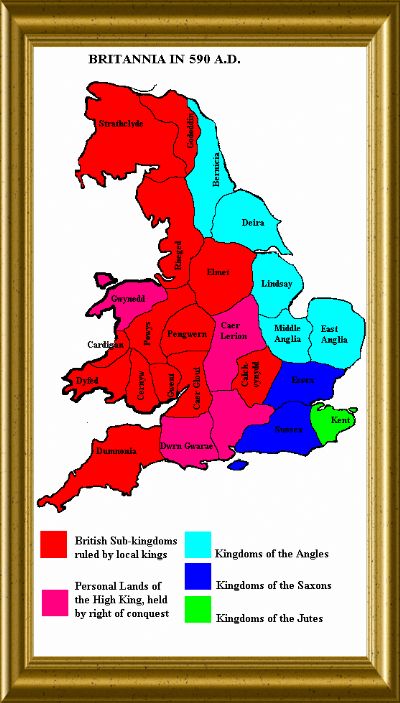RHEGED | Why The Name?
Sub-links for this page

~ The Eden Valley is believed to be the very heartland of the ancient kingdom of RHEGED ~
When trying to think up a name for a kennel prefix the name RHEGED sprung to mind immediately! The actual, mystical ancient kingdom of the British is not only a favourite area in England of Nikki's, it also suited the Welsh & English Springers breeds to a 'T' ~ & of course both Nikki's English heritage & Peter's Welsh ancestry.
The arrival at RHEGED Springer Spaniels of Talyessin (English; 'Taliesin'), our first Welsh Springer Spaniel, sealed the deal as it were, as Talyessin, aside from being the famous 6th Century Welsh Bard, wrote regularly about RHEGED & recorded the many exploits of the Kings, Chieftains & people of ancient 'RHEGED' in the 6th Century.
Our own RHEGED | photo album page

Or ‘Reged’' (as it is pronounced in the Welsh language), is described in poetic sources as one of the kingdoms of the ‘Hen Ogledd’ ('Old North'), the Brythonic speaking region of what is now northern England & southern Scotland, during the early Middle Ages. Its borders are not described in the poems, but some modern scholars have suggested that it included what is now Cumbria in North West England & possibly extended into Lancashire & Scotland. In the historical sources RHEGED is intimately associated with the king ‘Urien Rheged’ & his family. Its inhabitants spoke Cumbric, a Brythonic dialect closely related to Old Welsh.
LOCATION:
The name RHEGED appears regularly as an epithet of a certain ‘Urien’ in a number of early Welsh poems & royal genealogies. His victories over the Anglian chieftains of ‘Bernicia’ in the 2nd half of the 6th century are recorded by ‘Nennius’ & celebrated by the bard ‘Taliesin’, who calls him 'Ruler of RHEGED'. He is thus placed squarely in the North of Britain & more specifically in Westmorland when referred to as 'Ruler of Llwyfenydd' (the 'Lyyennent' valley). Later legend associates 'Urien' with the city of Carlisle, only 25 miles away; Higham suggests that RHEGED was 'broadly conterminous with the earlier Civitas Carvetiorum, the Roman administrative unit based in Carlisle'. Although it is possible that RHEGED was merely a stronghold, it was not uncommon for sub-Roman monarchs to use their kingdoms name as an epithet. It is generally accepted therefore that RHEGED was a kingdom covering a large part of modern Cumbria.
Place name evidence from ‘Dunragit’ (possibly 'Fort of RHEGED') suggests that, at least during one period of its history, RHEGED extended into Dumfries & Galloway. More problematic interpretations suggest that it could also have reached as far south as Rochdale in Greater Manchester, recorded in the Domesday Book as ‘Recedham’. The River Roch on which Rochdale stands was recorded in the 13th century as 'Rachedor Rache'. These place names may (apparently) incorporate the element 'RHEGED' precisely because they lay on or near its borders. Certainly 'Uriens' kingdom stretched eastward at one time as he was also 'Ruler of Catraeth' (modern 'Catterick' in North Yorkshire).
KINGS OF RHEGED:
The traditional royal genealogy of Urien & his successors traces their ancestry back to 'Coel Hen' (alias ‘Old King Cole’), who may have ruled much of the North in the early 5th century. It is generally assumed that all of those listed ruled in RHEGED, but only 3 of their number can be verified from external sources:
- 'Meirchion Gul', also known as 'Cynfarch fab Meirchion'; father of 'Cynfarch Gul'
- 'Cynfarch Oer', who gave his name to the family tribe; father of 'Urien'
- 'Urien RHEGED', (c. 550 – 590), about whom survive 8 songs of 'Talyessin' (‘Taliesin’)
- 'Owain', also celebrated for having fought the Bernicians; son of 'Urien'
A 2nd royal genealogy exists for a line, perhaps of kings, descended from 'Cynfarch Oer's' brother: ‘Elidir Lydanwyn’. According to ‘Bonedd Gwyr y Gogledd’, 'Elidirs' son, 'Llywarch Hen', was a ruler in North Britain in the 6th century. He was driven from his territory by princely in-fighting after 'Uriens' death & was perhaps in old age associated with 'Powys'. However, it is possible, because of internal inconsistencies, that the poetry connected to 'Powys' was associated with 'Llywarchs' name at a later, probably 9th century, date. 'Llywarch' is referred to in some poems as king of South RHEGED, & in others as king of 'Argoed', suggesting that the 2 regions were the same. Searching for 'Llywarchs' kingdom has led some historians to propose that, as was common in later Brythonic kingdoms, RHEGED may well have been divided between sons, resulting in northern & southern successor states. The connections of the family of 'Llywarch' & 'Urien' with 'Powys' have suggested to some, on grounds of proximity, that the area of modern Lancashire may have been their original home.

~ Map of Britain in 590 AD ~ showing 'RHEGED' & neighbouring kingdoms. ~
THE GAELS & OTHER CELTIC SPEAKING PEOPLES IN RHEGED:
There is considerable evidence for a Hiberno-Scottish presence in RHEGED. It is known that missionaries were active in sub-Roman Cumbria (although the region was at least nominally Christian), as indicated by several early church dedications to St Columba and St Kentigern, also known as 'Cyndeyrn Garthwys'. There were probably traders, slavers, pirates & settlers unconnected with the church as well.
THE END OF RHEGED:
After Bernicia united with Deira to become the kingdom of Northumbria, RHEGED was annexed by Northumbria, some time before AD 730. There was a royal marriage between Prince (later King) 'Oswiu of Northumbria' & the Rhegedian princess ‘Riemmelth’, granddaughter of ‘Rum’ (‘Rhun’), probably in AD 638, so it is probable that it was a peaceful takeover, both kingdoms being inherited by the same man. In the 10th century, after the power of Northumbria was destroyed by Viking incursions and settlement, large areas west of the Pennines fell without warfare under the control of the British kingdom of Strathclyde, with Leeds recorded as being on the border between the Britons & the Norse Kingdom of York. This may have represented the political assertion of lingering British culture in the region. The area of Cumbria remained under the control of Strathclyde until the early 11th century when Strathclyde itself was absorbed into the Scottish Kingdom. The name of the 'Cymry' (Welsh people) has however survived in the name of Cumberland & now Cumbria.
RHEGED REMEMBERED:
The name RHEGED has today been adopted by the Rheged Discovery Centre close to Penrith in Cumbria. The centre has a number of retail outlets and cafés with a Cumbrian theme, as well as the largest turf roof in Europe and a giant cinema screen among whose films is one about the history of Rheged ~ it is well worth a day trip! After RHEGED was incorporated into Northumbria, the old Cumbric language was gradually replaced by Old English, Cumbric surviving only in remote upland communities.
All content copyright © 2015
